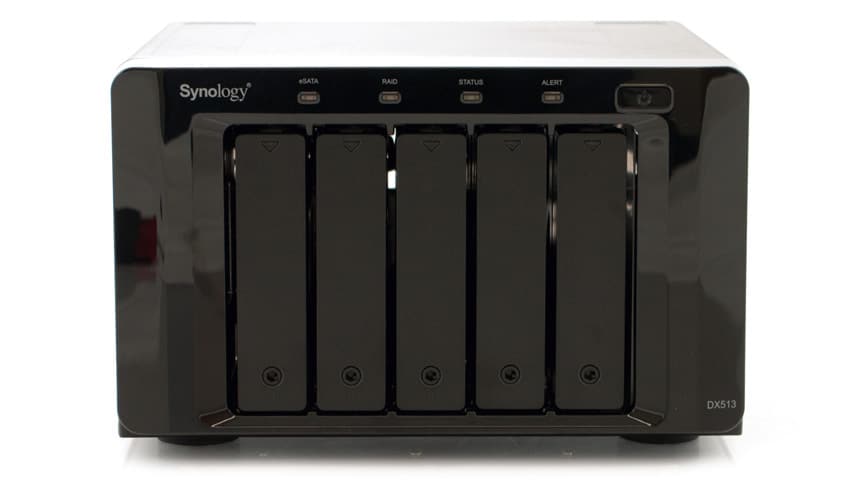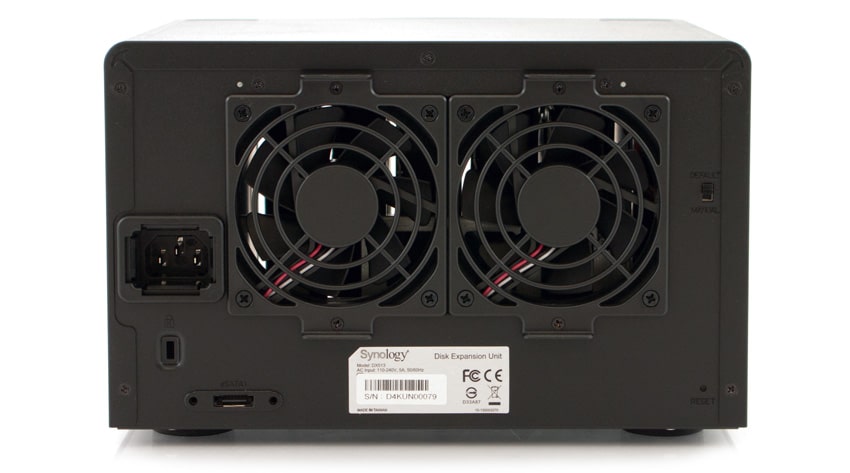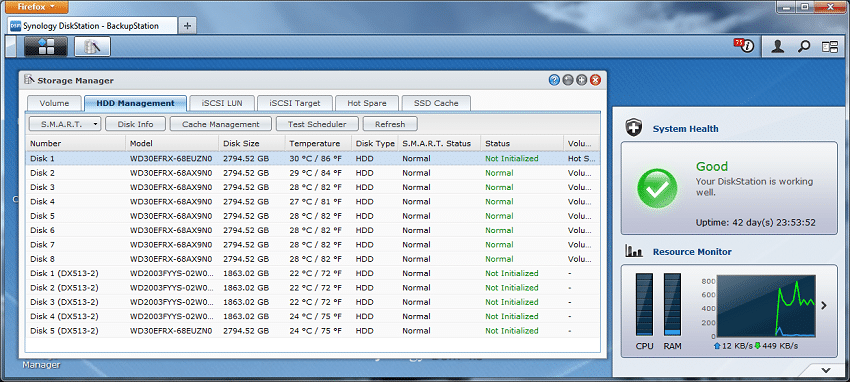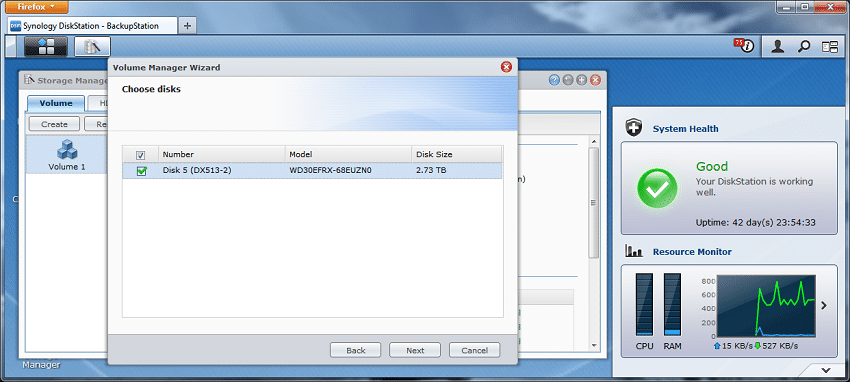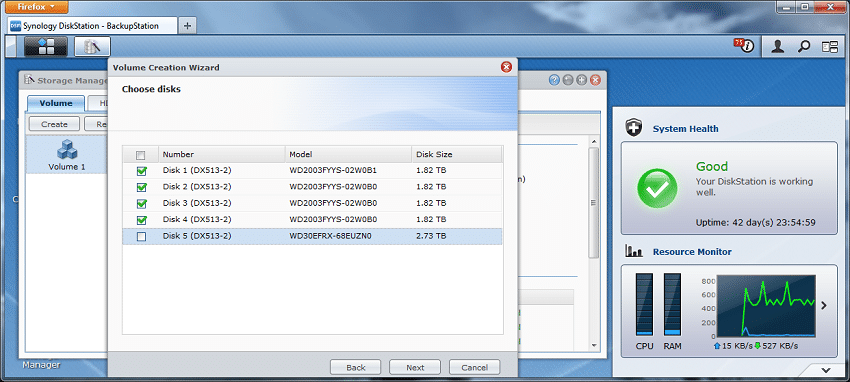
With the ever-increasing nature of enterprise-level storage demands, administrators not only have to focus on fulfilling current needs, but also keep an eye on scalability and future-proofing. Replacing or upgrading infrastructure can often be costly and time-consuming, to say nothing of inconvenience or lost opportunity. With this in mind, Synology offers a wide array of easy-to-use expansion units to be partnered with its flagship RackStation and DiskStation lines. While each of the seven offered expansion bay models are tailored to specific Synology RackStation/DiskStation products, they all share several common features that bring Synology’s ease-of-use philosophy full circle: plug-and-use design to minimize downtime, RAID management through Synology’s DSM software, and a commitment to energy efficiency.
As the RAID volume on the RackStation/DiskStation series can be expanded without going through the hassle of reformatting existing hard drives, the expansion units require no downtime during installation, thus ensuring that interruptions will be kept to a minimum. The expansion unit also provide for an excellent, cost-effective local backup solution to guard against data loss due to hard drive failure in the main device.
RX1214/RX1214RP
The RX1214/RX1214RP units offer hot-swappable 12 bay volume expansion for the following RackStation models: RS3614xs+, RS2414(RP)+, RS3413xs+, RS3412(RP)xs, RS3411(RP)xs, RS2212(RP)+, and RS2211(RP)+. While connecting to the RackStation via a multi-channel high-bandwidth expansion cable, drives installed in the RX1214/RX1214RP offer a level of performance matching those installed into the main unit itself, and SATA III 6gb/s interfaces ensure maximum throughput. The RX1214RP submodel also features two power supply units, ensuring that if one PSU fails, the unit automatically continues drawing power to prevent downtime and loss. In an effort to remain green and save on energy costs, the RX1214/RX1214RP offers Synology’s “Deep Sleep” functionality, allowing the administrator to specify power-saving functionality after a given period of inactivity.
RX1213sas
The RX1213sas provides a 12-bay expansion unit that is designed to pair with the RackStation RS10613xs+. This unit offers the same functionality as the RX1214(RP), but sports additional compatibility for SAS (serial attached SCSI) drives. The price for SAS compatibility, though, is a tradeoff against this unit’s lack of Deep Sleep energy-saving functionality.
RX1211/1211RP
This unit offers 12-bay expansion with the same features touted for the RX1214/RX1214RP, with compatibility for the following RackStation models: RS3413xs+, RS3412(RP)xs, RS3411(RP)xs, RS2212(RP)+, RS2211(RP)+.
RX410
Rather than sporting 12 bays like the other units we’ve so far listed, the RX410 delivers a much more compact 4-bay solution for the RackStation RS814, RS812(RP)+, RS812, RS810(RP)+ models aimed at small business and workgroup use. The RX410 provides the same green energy features and local backup functionality as its counterparts, but notably lacks a redundant power option.
DX1211
Breaking into the Synology DiskStation line, the DX1211 provides expansion of up to 12 hot-swappable drives for the DS2413+/DS3612xs, both aimed at medium-to-large scale office environments. It features the same energy-saving and local backup you would expect from its counterparts, but like the RX410 is lacking in an option for a redundant power submodel.
DX213/DX513
The DX213 and DX513 models round out Synology’s expansion units for those DiskStation models aimed at small office and home use. The DX213 provides for an additional 2 bays of expansion, while the DX513 provides 5. Both share the same easy plug-and-use design, power-saving features, and dedicated local backup functionality, while only the DX513 offers hot-swappable bays. While these two models are fully compatible with some DiskStation models (DS1813+, DS1812+, DS1513+, DS1512+, DS1511+, DS1010+, DS713+, DS712+, DS710+), they offer only independent volume compatibility for the smaller SOHO-targeted models (DS413, DS412+, DS214+, DS214play, DS213+, DS212+, DS114, DS112+, DS112).
Usability
One of the main advantages of the Synology expansion units is they operate exactly how a standard JBOD shelf would in an enterprise environment. Attach the unit, plug in drives and expand existing storage volumes or create new ones. In our usecase, we leveraged the DX513 to expand the volume size of our DiskStation DS1812+ for added capacity.
After adding a single DX513 to the DiskStation DS1812+ with five additional HDDs (four WD 2TB RE4 and one WD 3TB Red) the additional HDDs can be seen under HDD management with the (DX513-x) next to the disk number.
From this group the 3TB WD Red can be used to expand out existing 8-drive RAID6 volume seamlessly through the storage manager.
The other four HDDs can be used to create a new volume of any type (depending on the minimum drives required for a certain RAID type).
Conclusion
Being able to expand a NAS from small office use, up to enterprise-grade rack units might be assumed but isn’t always the case. In fact, many NAS vendors do not offer a way to increase capacity via expansion units at all, making the owner invest in another head unit, rather than adding an expansion shelf. Of course expansion shelves aren’t always the right solution to increasing capacity; if there’s a high load situation, a business may need to spring for a new head unit to pick up processing power. In most cases however, CPU and RAM consumption isn’t an issue and the Synology expansion options give everyone from a home or SOHO DiskStation to high performance SMB RackStations an option to scale up capacity in a seamless manner through DSM.
As outlined in our expansion walkthrough on the DiskStation DS1812+ with the DX513 expansion unit, expanding the capacity of existing volumes or disk groups is very simple. As soon as the expansion unit is connected the HDDs or SSDs become readily visible as if they were inserted into the main unit itself. From there select the drives through the standard storage manager to either expand an existing group or build a new one. From a management perspective, it can’t get any easier than that.
Pros
- Ease of deployment
- Simple management through DSM
- Support for small and large NAS systems
Cons
- DiskStation expansion units limited to single SATA channel
Bottom Line
Synology gives NAS owners a simple way to add capacity without forcing the purchase of a new NAS. Everyone from SOHO users on up to enterprise rack deployments benefit from the easy to deploy capacity bump Synology can facilitate across their entire lineup of NAS products.
Synology Expansion Units at Amazon



